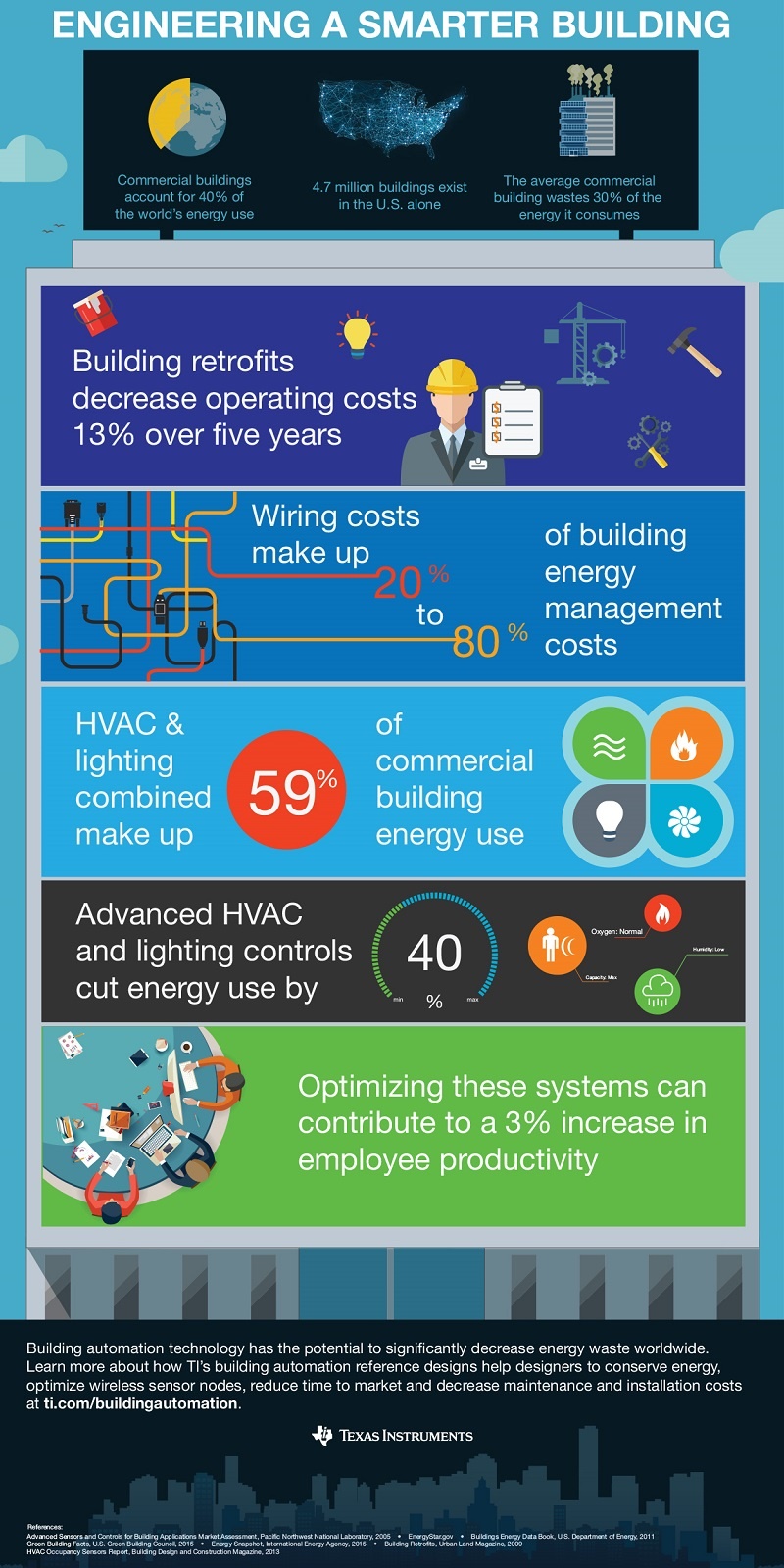SSZTBM4 February 2016
When it comes to building automation, wireless sensor networks (WSNs) and the Internet of Things (IoT) are becoming more and more prevalent in new and old buildings alike. WSNs enable us to add “smarts” to existing building infrastructures without worrying about additional wiring or installations in hard-to-reach areas.
Looking more and more into wireless systems, I often ask myself, “What is the purpose or reasoning for adding more sensors in an HVAC, lighting or a building security system?”
These key trends that help answer this question:
- Energy efficiency.
- Safety and security.
- User comfort.
The first part of this blog series will go over energy efficiency – an important trend for adding more sensors in building automation systems.
Whether you’re a building owner, homeowner or tenant, we all care about conserving energy and saving money. Today’s buildings use a large portion of the grid’s energy – and then waste 30% of that energy1. Creating a more intelligent building using sensor nodes geared toward reducing high-power-consuming equipment by operating it only when necessary could have a huge impact on conserving energy, reducing waste, and (arguably most important) saving some money on our bills.
Figure 1 is an infographic highlighting energy-consumption statistics for commercial buildings.
 Figure 1 Energy-consumption Statistics
for Commercial Buildings
Figure 1 Energy-consumption Statistics
for Commercial BuildingsIn HVAC systems, intelligent monitoring and control can be achieved by adding stand-alone environmental sensors, which will take accurate temperature and humidity readings for each zone or room throughout a building. For example, I will typically occupy just one room over the course of an evening. But I am still paying to heat or cool every room during that six- to eight-hour (if I’m lucky) period. Rather than having one central temperature-monitoring device, adding multiple sensors throughout a building gives you more options to control heating and cooling zones based on occupancy or time of day.
Large commercial buildings can use people-counting systems for demand control ventilation (DCV). DCV adds fresh air based on the amount of people occupying a room, rather than having the HVAC system turn on based on a preset control regardless of the number of occupants present.
HVAC and lighting systems alone make up 59% of the energy used by a commercial building2. The energy use of these applications can be vastly impacted by intelligent monitoring and control solutions. By implementing connected sensors for advanced lighting control (low power occupancy detectors and energy harvesting daylight sensors) and adding connected sensors for advanced HVAC control (low power environmental sensors and people-counting systems), we can really begin chomping down on overall energy consumption. Hopefully this infographic inspires you to take another look at connected sensing in HVAC and lighting systems. For a jump start on connected sensing, be sure to check out building automation TI Designs and the additional resources below.
References:
1) EnergyStar.gov
2) U.S. Department of Energy, Big Data Book
Additional Resources
- Find more building automation design resources
- View the interactive wireless sensor block diagram
- Watch the building automation webinar
- Download the infographic
- Check out these wireless sensor node reference designs:
- Environmental sensor node: Humidity and Temp Sensor Node for Sub-1GHz Star Networks Enabling 10+ Year Coin Cell Battery Life.(TIDA-00484)
- Wireless PIR motion detector: Low Power Wireless PIR Motion Detector Reference Design Enabling 10 Year Coin Cell Battery Life. (TIDA-00489)
- Wireless gas sensor: Always-on Low-power Gas Sensing with 10+ Year Coin Cell Battery Life Reference Design.(TIDA-00756)